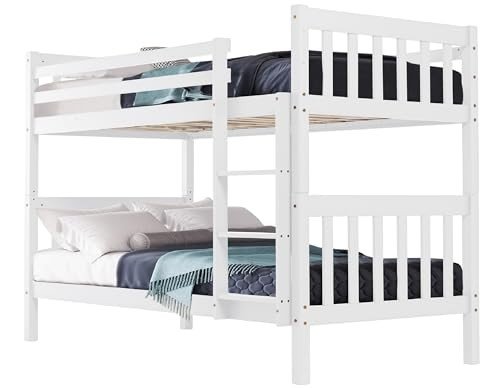You'll Never Guess This Bunk Beds Sale's Secrets
Bunk Beds Sale: A Comprehensive Guide to Choosing the Right Bunk Bed for Your Home
Bunk beds have long been a staple in kids's bedrooms, offering a combination of space-saving efficiency and fun. Whether accommodating brother or sisters, pals on sleepovers, or just maximizing a playroom, bunk beds have actually become a vital element in modern-day family homes. As sales on bunk beds increase, it ends up being increasingly crucial for consumers to make informed choices when purchasing one. This post will cover the basics of purchasing a bunk bed, from types to security features, in addition to suggestions for maintaining the integrity of your investment.
Kinds Of Bunk Beds
When thinking about a bunk bed sale, it's important to comprehend the various designs readily available on the market. Below are the most typical types:
Traditional Bunk Beds: These include two beds stacked one above the other, sharing a single frame. They are often the most cost-effective option.
L-Shaped Bunk Beds: This design features one bed positioned vertically and another horizontally. This plan develops extra space beneath the upper bed, which can be used for storage or a backyard.
Lofted Beds: Similar to standard bunk beds but with no lower bed. Rather, the space underneath can be used for a desk, play area, or additional storage.
Triple Bunk Beds: For households with a larger number of children or frequent slumber parties, triple bunk beds offer 3 sleeping locations in a space-efficient design.
Futon Bunk Beds: These styles merge bunk beds and futon sofas. The bottom section transforms into a different seating location, enhancing functionality.
Convertible Bunk Beds: These beds can be separated into 2 specific beds, making them flexible as children's requirements alter gradually.
Table 1: Comparison of Bunk Bed Types
Type
Description
Space Efficiency
Extra Features
Traditional Bunk Bed
2 beds stacked vertically
High
Most basic style
L-Shaped Bunk Bed
One vertical and one horizontal bed
Moderate
Play or storage space
Lofted Bed
Elevated bed with open space below
High
Work/play area
Triple Bunk Bed
3 stacked beds
Very High
Accommodates more users
Futon Bunk Bed
Bunk bed with a convertible futon
High
Multi-functional
Convertible Bunk Bed
Can be divided into 2 different beds
Moderate
Versatility & & durability
Security Features to Consider
Safety is paramount when investing in a bunk bed. Below are essential safety functions to search for:
Guardrails: Adequate guardrails ought to exist on both sides of the upper bunk to avoid falls. They should be at least 5 inches greater than the bed mattress.
Ladder Design: Look for tough, broad ladders with slip-resistant rungs. Guarantee that the angle is not too high for easy gain access to.
Stability: Ensure the bed is constructed with strong materials, such as solid wood or durable metal. The bed ought to not wobble when in usage.
Weight Limit: Check the weight capability of the bunk bed to guarantee it can accommodate the designated users securely.
Product Safety: If possible, choose beds made from non-toxic products or those satisfying security standards for children's furniture.
Table 2: Essential Safety Features
Function
Description
Value
Guardrails
Sides of upper bed to prevent falls
Necessary for kid security
Ladder Design
Strong, slip-resistant rungs
Help safe and easy gain access to
Stability
Develop quality to avoid wobbling
Makes sure security and durability
Weight Limit
Optimum weight capability
Prevents mishaps
Product Safety
Non-toxic, safe products
Protects children's health
Upkeep Tips for Bunk Beds
To extend the life of your bunk bed and guarantee continuous safety, think about the following upkeep suggestions:
Regular Inspections: Periodically inspect the structure for loose screws, bolts, or any indications of wear. Tighten visit the following web site .
Clean Periodically: Dust and clean the surfaces regularly. Usage proper cleaners that won't damage the finish.
Check Weight Limits: Be conscious of weight limitations, especially with older children or adults who may want to use the upper bunk.
Prevent Climbing on Guardrails: Educate children not to use guardrails for climbing up or playing to decrease the risk of accidents.
Regularly Asked Questions (FAQs)
Q1: What is the age limitation for children to securely utilize bunk beds?A: While it differs by the producer, many suggest that kids under 6 must not sleep in the upper bunk due to safety concerns.
Q2: How can moms and dads discourage hazardous climbing?A: Setting clear rules about bunk bed use and supervising children can help. In addition, using a bed camping tent can discourage climbing up while creating an enjoyable sleep environment.
Q3: What should I consider when decorating a room with bunk beds?A: Ensure there suffices space around the bunk bed for safe motion, and use the decoration to create individualized spaces for each child.
Q4: Is a lofted bed ideal for older children?A: Yes, lofted beds can be appropriate for older kids as long as they fulfill safety requirements and the kid is accountable enough to use them securely.
Bunk beds serve a practical purpose while adding a component of fun to a child's bed room. As sales of bunk beds continue to increase, cautious consideration of types, safety features, and maintenance practices is essential for moms and dads and caregivers. By comprehending these crucial aspects, families can discover the perfect bunk bed for their home, ensuring both functionality and safety for several years to come. Whether it's for brother or sisters sharing a room or producing a relaxing sleepover space, a well-chosen bunk bed can provide delight and functionality, making it a worthy investment.
